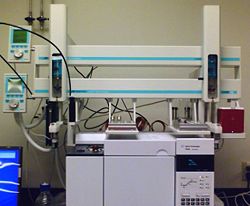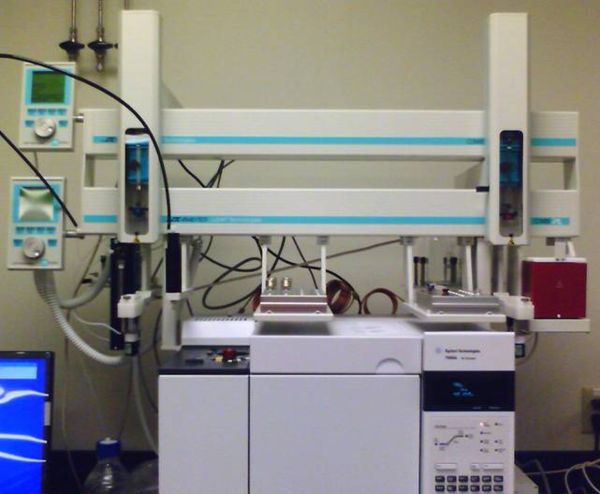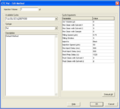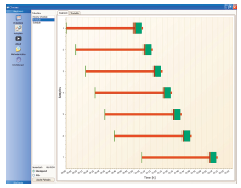ASTM6584 Glycerin content by GC
From LEAP

| Biofuels |
| Application Type | |
| Sample Prep and Inject | |
| Application ID | |
| Biodiesel ASTM 6584 | |
| Description | |
| Determination of Free and Total Glycerin in B-100 Biodiesel Methyl Esters by Gas Chromatography |
Contents |
Overview
Glycerin content can indicate the quality of biodiesel. Glycerol is formed as a by-product and separated from biodiesel in the production process, however, traces thereof can be found in the final biodiesel product. Glycerin can be in the form of free glycerin or bound glycerin in the form of glycerides. Total glycerin is the sum of these. A high or excessive content of free and total glycerin can lead to buildup in fuel tanks, clogged fuel systems, injector fouling and deposits on valves and pistons. Unrelated glycerides and free glycerin make the product behave more like soap rather than fuel.
American Society for Testing and Materials (ASTM) created ASTM Method D6751 specifications serve as the benchmark which identifies the standards that pure biodiesel (B100) must meet before being used as a fuel or blended with petrodiesel. There are 14 different required tests according to ASTM D6751-03. The US National Biodiesel Board has adopted the ASTM biodiesel specification and analytical methodology. ASTM recommends test method ASTM D6584 for the analysis of glycerin in biodiesel fuel by gas chromatography.
ASTM Method D6584 specifies the use of a gas chromatograph (GC) equipped with a cold on-column injector and an FID detector. ASTM D 6584 provides for the quantitative determination of free and total glycerin in B-100 methyl esters by gas chromatography. The range of detection for free glycerin is 0.005 to 0.05 mass%, and total glycerin from 0.05 to 0.5 mass %. This method is not applicable to vegetable oil methyl esters obtained from lauric oils, such as coconut oil and palmkernel oil. ASTM Method D6584 deals with expensive and toxic reagents and requires very complex and time consuming procedures for preparing calibration standards and finished B100 biodiesel. ASTM-6584 requires a two internal standard, five-point calibration curve be generated for free Glycerine, Monoglycerides, Diglycerides and Triglycerides. Manual standards and sample preparation remains a tedious chore that can significantly contribute to errors and lost precision in the GC analysis. Automation can help with all of these. Analyzing the amount of free and total glycerin in the form of mono-, di- or triglycerides during the esterification process is mandatory when manufacturing biodiesel.
Gas chromatography (GC) is ideal for measuring important parameters such as total glycerin, fatty acid methyl esters (FAMEs) and methanol levels in biodiesel fuel. Methods like ASTM D-6584 and EN14105 are the standards for testing total glycerin and glycerides in biodiesel oil.
Gas chromatography (GC)can also serve as a tool for process troubleshooting during biodiesel production to ensure trouble-free operation of the fuel in diesel engines. Monitoring the level of free glycerin and any unrelated mono-, di-, and triglycerides will indicate the efficiency and progress of the chemical reaction during the process of making biodiesel.
Significant Markets
- Biodiesel Manufactures
- Biodiesel Blenders
- Biodiesel Distributors
- Biofuels CROs
- Fleet Managers
ASTM Method D6584
9. Calibration and Standardization
9.2 Standard Solutions – Prepare the five standard solutions in Table 3 by transferring the specified volumes by means of microliter syringes to 10mL septa vials
- Add to each of the five standard solutions 100uL of MSTFA
- Shake the vial
- Allow the vial to stand for 15 to 20 minutes at room temperature
- Add approximately 8 mL n-Heptane to vial
- Shake the vial
| Standard Solution Number | 1 | 2 | 3 | 4 | 5 |
|---|---|---|---|---|---|
| uL of glycerin stock solution | 10 | 30 | 50 | 70 | 100 |
| uL of monoolein stock solution | 20 | 50 | 100 | 150 | 200 |
| uL of diolein stock solution | 10 | 20 | 40 | 70 | 100 |
| uL of triolein stock solution | 10 | 20 | 40 | 70 | 100 |
| uL of butanetriol stock solution | 100 | 100 | 100 | 100 | 100 |
| uL of tricaprin stock solution | 100 | 100 | 100 | 100 | 100 |
9.4 Standardization
9.5 Inject 1 uL of the reaction mixture into the on-column injection port and start the analysis.
10. Procedure
10.1 Weigh to the nearest 0.1 mg approximately 100 mg of sample directly into a 10 mL septa vial.
- Using microliter syringes, add exactly 100 uL of each internal standard and MSTFA.
- Shakethe vial
- Allow to set for 15 to 20 minutes at room temperature
- Add approximately 8 mL n-Heptane to vial
- Shake the vial
10.2 Inject 1 uL of the reaction mixture into the on-column injection port and start the analysis.
LEAP's Approach
This digital application note describes a LEAP turn-key system for the analysis of free and total glycerines in biodiesel fuel.
LEAP uses a Twin PAL to solve this application due to the many different solvent, internal standard, and sample volumes required.
The Lower PAL is the Prep PAL and runs on Cycle Composer Software. All of the sample prep is performed with this PAL. There is a 100ul syringe for the solvent transfers. There are (7) 2mL solvent locations. There is a DISPTool that is hooked up to a 5 mL dilutor syringe for the 8 mL Heptane addition. There is a wash station for the through cleaning of the syringe that has two wash solvents. Wash1 is filled with Toluene and Wash 2 is filled with Heptane. There is an agitator that is set at 35 deg C and 500RPM to do the mixing.
The Upper PAL is the Inject PAL and runs under ChemStation Software control using the Agilent CTC Control Software. It is using a 5 ul syringe with a tapered needle to do 1 ul on column injection into the rear injection port. There is a wash station for the through cleaning of the syringe]that has Wash1 is filled with Toluene and Wash 2 is filled with Heptane.
The expected Sample Prep Time is approximately 26 minutes
The expected GC Runtime is approximately 31.81 minutes
The expected GC Cool down time is approximately 7 minutes
Software Control
The Lower PAL is the Prep PAL and runs on Cycle Composer Software.
The Upper PAL is the Inject PAL and runs under Agilent ChemStation control.
This process can be done on other GC's and data systems and does not require the Agilent approach.
Also, LEAP now has the ability use the new Chronos Software as it organizes parallel processes for sample preparation. This utilizes the analysis system to a much greater extent, while observing the time margins of each individual sample preparation. There is a single sample list for the entire process and integrates well with Xcalibur from Thermo Scientific and ChemStation from Agilent .
Screenshots
Video
![]() Dispense tool in action on youtube
Dispense tool in action on youtube
Useful links
![]() An overview of all tests that must be run by Piedmont Biofuels
An overview of all tests that must be run by Piedmont Biofuels
![]() A good general reference site by Agilent
A good general reference site by Agilent
![]() UCONN.com A good general reference site on Biodiesel ASTM Methods
UCONN.com A good general reference site on Biodiesel ASTM Methods
![]() A good general reference site on Biodiesel
A good general reference site on Biodiesel
More Info
To get to the main LEAP digital brochure for other applications: LEAP Wiki Main Page
Info on EN 14110 Methanol content by HS
Info on ASTM D 5453 Sulfur Content
![]() More info on the TWIN PAL
More info on the TWIN PAL
![]() More info on LEAP Accessories
More info on LEAP Accessories
![]() More info on Large Volume Dispensing
More info on Large Volume Dispensing
![]() More info on Washing the Syringe
More info on Washing the Syringe
![]() More info on Shaking and Agitation
More info on Shaking and Agitation
![]() More info on the Dilutor
More info on the Dilutor
![]() More info on On-Column
More info on On-Column
![]() More info on Reagent Storage
More info on Reagent Storage
![]() More info on the PAL
More info on the PAL
Videos of PAL
![]() LEAP's PAL Application Videos on YouTube
LEAP's PAL Application Videos on YouTube
Info on Chronos software from LEAP Technologies
Chronos Mastersoftware is an ideal solution for automating complex GC Sample Preparation steps on the CTC PAL. Software Integration with data systems ChemStation™ or Xcalibur™ assures seamless functionality with existing systems. Chronos not only exchanges information with other systems, but also controls the complete process and optimizes intelligent time-management resulting in significant improvement in system throughput.Single Sample List Control – including the flexible Twin PAL
Chronos Mastersoftware for organizing parallel processes for sample preparation
LEAP provides automated workstation instrumentation solutions based on the LEAP CTC PAL X, Y, Z syringe only autosampler robot from LEAP Technologies. This extremely flexible, precise, and adaptable liquid handling robotic platform is available in a variety of lengths and options depending on the requirements of your sample preparation and injections for your UHPLC, LC or GC chromatography.LEAP offers full support and service for the PAL platform in addition to being able to write custom macros, cycles, and scheduling to your applications. Please contact LEAP Technologies on how we can help you get maximized throughput with flexible pipetting automation solutions.
Contact LEAP
For additional information about the PAL and the application, please contact LEAP Technologies. |
Keywords
biodiesel, free glycerin, gas chromatography with FID, methyl esters, total glycerin, American Society for Testing and Materials (ASTM), product quality, cold on column,










